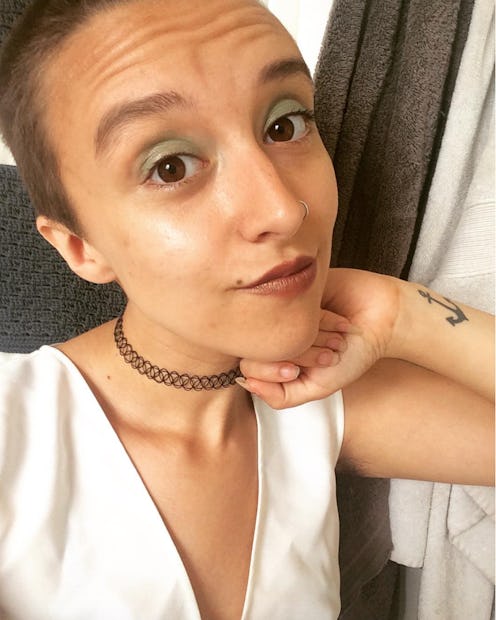Fashion
To Those Who Are Less Visibly Queer

Many of us are taught to believe some pretty specific things regarding what "androgyny" looks like. As reflected in many so-called gender fluid looks on the runway, women rocking short cuts and menswear seem to be the extent of the mainstream definition. For that reason, trans visibility arguably suffers. So many of my queer and trans friends — and myself — feel restricted by these standards. It's as if we're being told that we are somehow less authentic in our identities because our presentations don't match the status quo. Our long hair somehow makes us less masculine. Our beards cancel out our femininity. We simply don't look "queer enough."
But as someone who's been through these feelings, desperately trying to be "the real deal" in my trans-ness for so long, I'm saying to hell with those standards. As gender nonconforming people, the pressure that we so often feel to conform to strict definitions of "male," "female," or "nonbinary" in our communities is an irony with consequences that are far from amusing.
For much of my life, I've had long hair. As I grew older and began to get to know my community and my own queer identity, I started realizing that my hairdo was out of place. As I looked at the queer folks around me on my college campus, I saw mostly people assigned female at birth donning short hair, chest binders, and facial piercings. I admired their aesthetics and respected our differences — until I was quite forcibly rejected from the queer space for "looking too cisgender and heterosexual." It's an experience that perplexes me to this day.
According to specific ideas of queerness and androgyny, I didn't "look the part" for some time. My long mane just didn't correspond with the masculinity I so closely identified with. Or at least, it appeared that way to the people around me.
My aesthetic has changed a lot since then, as I've abandoned my long locks and added some body modifications over the years. But even as I began to look the part with each passing month, my love for makeup and skirts and my distaste for chest binders continued to set me apart from being visibly genderqueer or masculine in the eyes of many both in and outside of my community.
The temporary affection I would receive from my transmasculine friends whenever I cut my hair or dyed it a wacky hue helped brew a lot of resentment within me regarding maintaining a stereotypically queer aesthetic. I hated the "rules" my community seemed to be playing by, and felt that I had lost a safe space I had been desperately in need of for years.
Unfortunately, the queer people I knew were doing a lot of "judging a book by its cover," regardless of the environment of safety and acceptance they were trying to cultivate. Without the buzzcut that I have now and the flat chest that I may never achieve, my genderqueerness seemingly became invisible to them.
Choosing to have longer hair was not a choice I made with the intention of denying the gender fluidity of myself or others. Choosing to inhabit my own style and not copy the queer kids at my school had nothing to do with my activism or commitment to breaking the gender binary. Like many, I choose my aesthetics based on preference and comfort. They are choices that sometimes further affirm my gender identity (which is rad). But I never judge others for being less identifiably "androgynous" based on what we're taught the word means. Everyone's androgyny looks radically different, which is part of the beauty of being queer and gender nonconforming: We break rules rooted in gender and otherwise oppressive systems.
Too many of my genderqueer pals have been made to feel less authentic because of their long flowing hair or thick, dark beards, since their supposedly cishet appearances block them from being able to pass as gender fluid or trans. But upholding our friends and ourselves to the politics of passing does more harm than good, from my experiences, by reinforcing new binaries and stereotypes.
Why should we care about these standards or expend energy creating new ones when our very existence is tied to rule-breaking? Hair is hair and style is style — and no sartorial choice you decide upon should make you feel less worthy of or true to your gender identity.
Personally, I feel most comfortable with a buzzed head complemented by a ton of highlighter and bold lipstick. And though the former satisfies my masculinity, that's simply not the case for everybody. I accept that some of us people AFAB can still feel masc AF in a skirt or a lacy bra, and that some folks AMAB feel the most femme and fancy-free on days when they skip the razor.
You can certainly express gender in your clothing, but presentation isn't everything. We all have vastly different, strange, and beautiful bodies; so, in reality, femininity, masculinity, and androgyny can look like a million unique things individual to individual. As someone who couldn't care less about binaries or conformity, this feels like a truly beautiful thing and something we should all learn to embrace.
Images: Meg Zulch